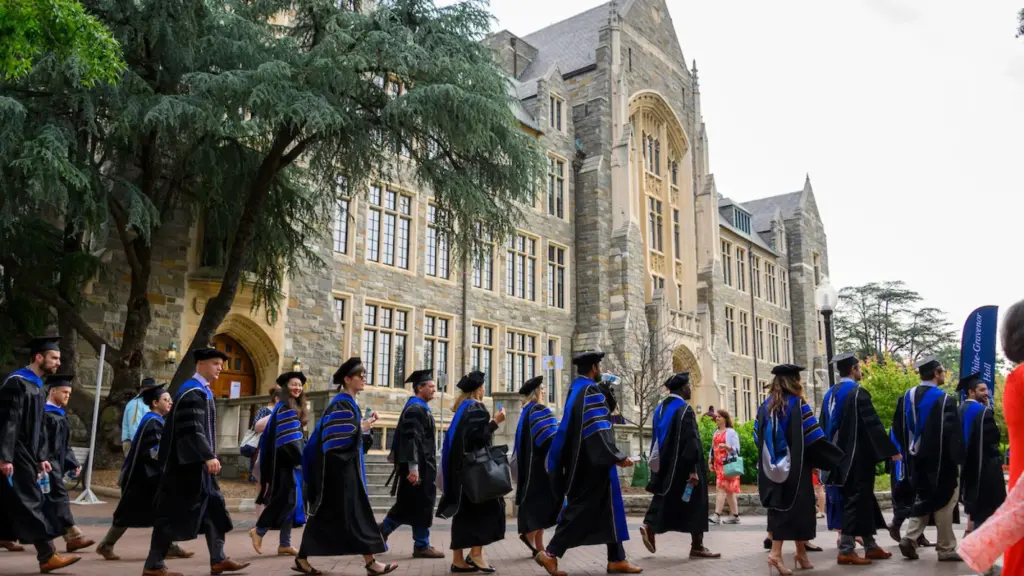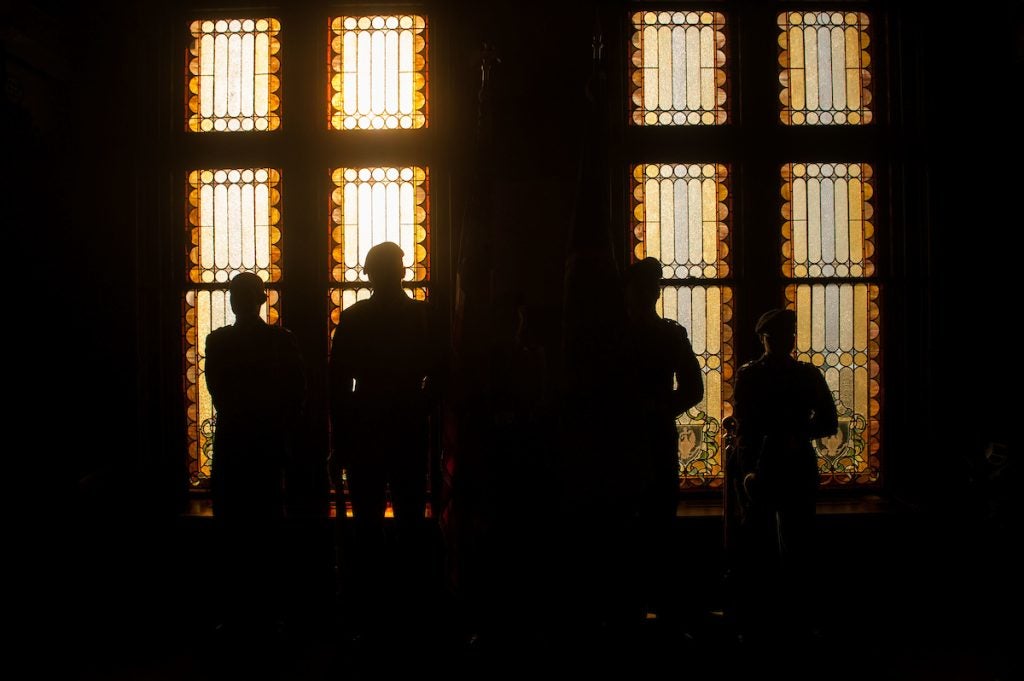‘Walk the Earth in Peace’ – Georgetown Alum Ken Rutherford on Losing His Legs and Finding Purpose
On December 13, 1993 in the Gedo Region of Somalia, Ken Rutherford (G’87, G’00) almost died.
While working with a non-government organization in war-torn Somalia, the group he traveled with was headed out to a site when his vehicle passed over a hidden landmine.
“It is crazy how my near-death experience cleared out the noise,” Rutherford said. “Unlike most mine victims, I was lucky to be able to call for help on my hand-held radio.”
He’s now a professor at James Madison University and advocates for people with disabilities from landmine explosions around the world.
Explore Rutherford’s journey and how losing his legs helped him find his purpose.
Path to Georgetown
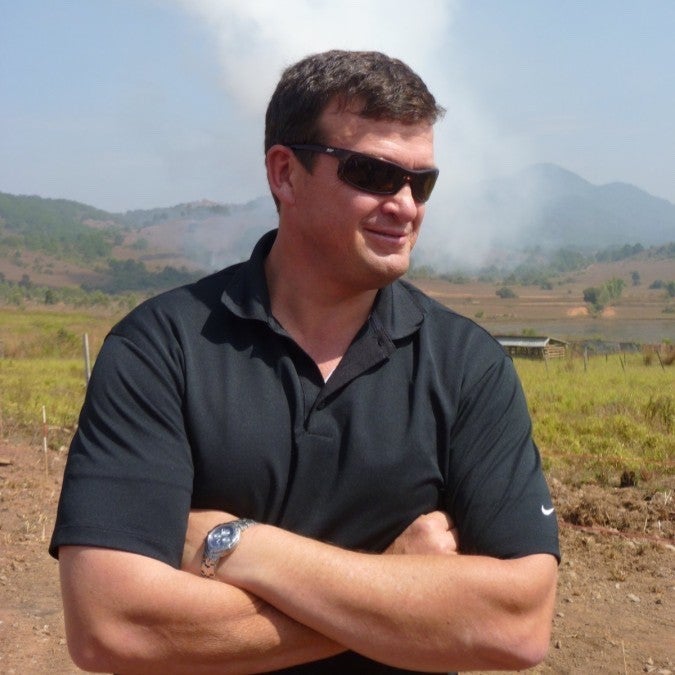
Ken Rutherford
Originally from Boulder, Colorado, Rutherford first came to Washington, DC, as part of the Close Up program in 1979. During one free afternoon, he visited Georgetown’s campus and fell in love with the overall atmosphere, telling himself that one day he’d study here.
After earning his B.A. and MBA from the University of Colorado, and an MLS from Georgetown in 1987, he went out into the world to effect change. This included short-term projects as a Peace Corps volunteer in Mauritania (1987-89), a UNHCR Emergency Refugee Coordinator in Senegal (1989), and a humanitarian emergency relief officer in Kenya and Somalia (1993).
It was in Somalia that Rutherford came face-to-face with death.
“When the landmine exploded, I was temporarily blinded,” he recalls. “Sitting in the middle front seat with my legs angled to the right, I was the most seriously injured passenger. The passengers were my Somali team and three recently returned refugees – it was their project that we were going to visit when the landmine exploded. My right foot was blown off and was held on only by skin. My left foot had a hole blown through it, although I didn’t know that at the time.”
Despite the trauma, Rutherford was able to maintain awareness enough to apply tourniquets to his ankles to help stop the bleeding and to pray. As he lay there, waiting for the local Islamic clan militia to help him, he thought he was going to die in the desert. Rutherford also thought about his eulogy, mentally noting the following three things: that he wanted to 1) marry his fiancée Kim (they had just gotten engaged), 2) be a father and 3) become a professor.
As he was recovering from the loss of his right leg and badly damaged left foot, which required 19 blood transfusions at five hospitals in five different countries within the first three weeks of the accident, Rutherford knew he had to find a new career. He had always admired his father, who was a professor, and how he was able to mold young people while also enjoying his work. This reminded him of his own childhood dream to become a professor.
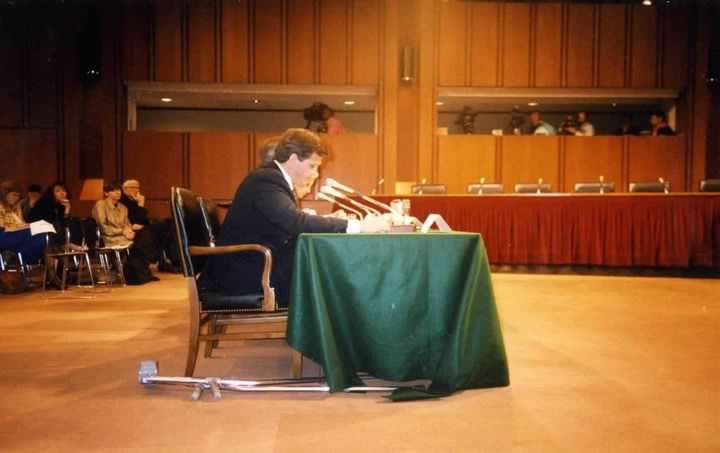
Rutherford testifies before U.S. Senate Sub-Committee (May 1994)
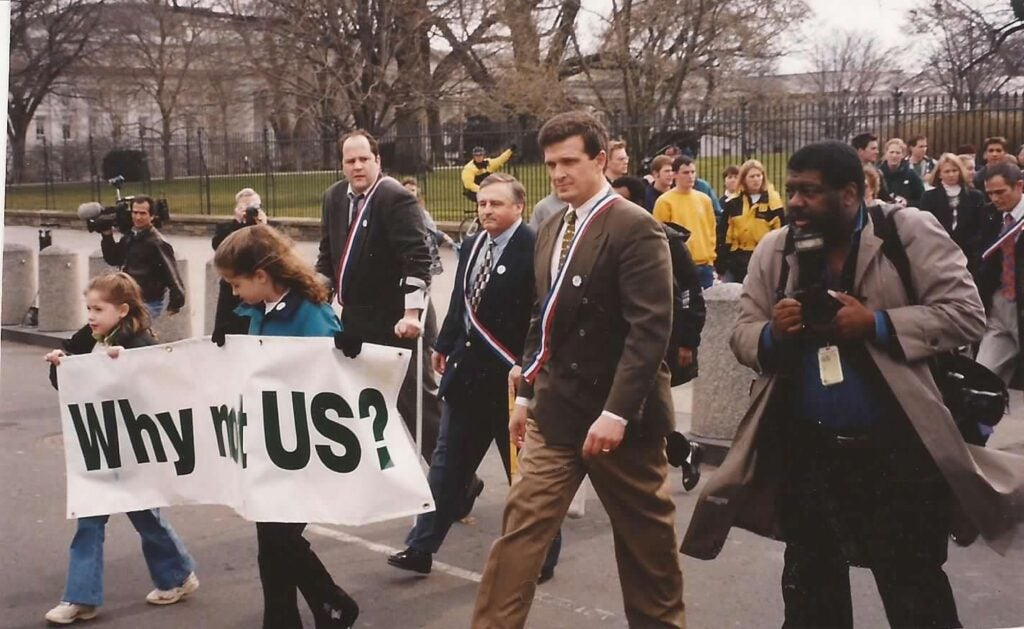
Rutherford walks during protest in DC (October 1999)
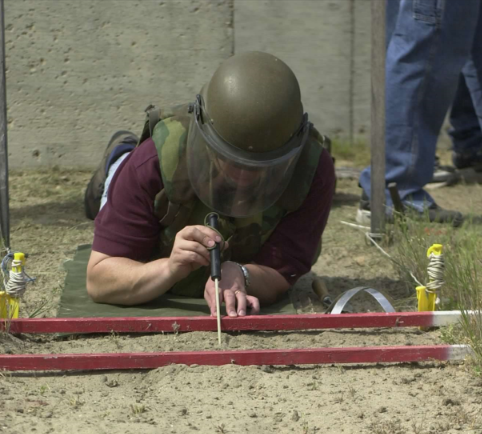
Rutherford at a training to clear landmines (2001)
After national media interviews related to Rutherford’s landmine accident, a visit to the White House and his testimony in front of the Senate at the “Global Landmine Crisis” hearing in May 1994, he became an advocate for others with disabilities related to landmine explosions. He also applied for Georgetown’s Ph.D. in government program and was admitted to start in the fall of 1995. The journey wasn’t easy, however, as he had to navigate his doctoral program, the additional amputation of his left leg and physical therapy. He credits the faculty in his program, Theresa Torres in the Financial Aid Office, and especially his wife, Kim, for being the glue that held him and his growing family together throughout his studies.
“The five years studying at Georgetown was the hardest and most satisfying of my life,” said Rutherford. “I learned resilience, tenacity and compassion. Everything happens for a reason.”
He noted that professors Anthony Arend, Andrew Bennett, William Gormley, Christopher C. Joyner (his dissertation advisor, now deceased) and George Shambaugh were fundamentally instrumental to his career success since then.
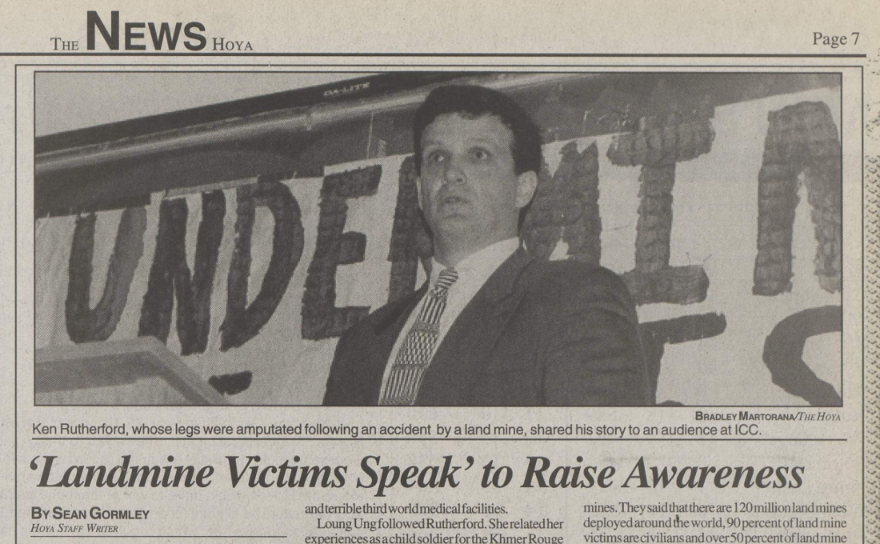
Clipping from The Hoya newspaper featuring Ken Rutherford (February 26, 1999)
His activism efforts also made it into two issues of The Hoya (October 28, 1997 and February 26, 1999). In particular, the story in the 1999 issue had several pieces on the approaching International Landmine Ban set to go into effect on March 1 of the same year. Rutherford, along with two other speakers and survivors of war-torn regions, Loung Ung and Irvin Axelrod, praised the actions of the student group Georgetown Peace Action for “publicizing the devastation of landmines.”
Rutherford finished his dissertation in 2000 with four children under the age of five as a double amputee. While he was a student, Rutherford started traveling the world to advocate for banning landmines, including developing and launching the Landmine Survivors Network (LSN), later named Survivor Corps before it was closed in 2010.
Making Global Connections
During his graduate school years, Rutherford met and worked with celebrities to raise awareness for landmines. None was more iconic than the UK’s Princess Diana, who was all in when it came to her support of his work and others more broadly.
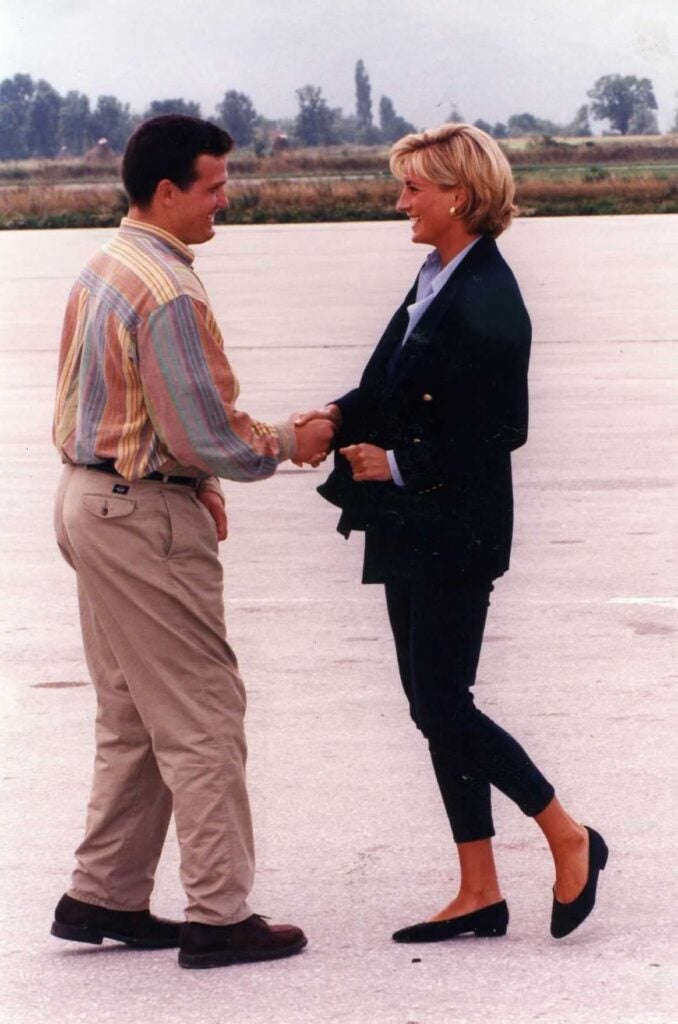
Ken Rutherford (left) welcomes Princess Diana (right) in Sarajevo on August 8, 1997
Reflecting on their first meeting, Rutherford was struck by how Diana wanted to work with the Landmine Survivors Network, despite it being a new organization.
“She knew that the media spotlight would be on her, but if she traveled to personally meet survivors it would effect greater positive change,” he said. “She brought the global landmine crisis issue to the living rooms of the world.”
The victim assistance language within the 1997 Landmine Ban Treaty was in large part due to Diana highlighting the plight of victims with her charities.
“She lobbied the world to support anti-landmine measures in their own countries to reach a global ban standard,” he noted. In speaking alongside her in London, DC and Bosnia, Rutherford observed that her appearances left many in the audience speechless. He has since kept in touch with the Royal Family, and was interviewed for a 2017 HBO documentary made by Princes William and Harry on the 25th anniversary of their mother’s passing. Rutherford was even mentioned by name in the sixth season of the Netflix series The Crown.
Also in 1997, as LSN Co-Founder, Rutherford co-shared the Nobel Peace Prize with the International Campaign to Ban Landmines. He found out about this award from the news and felt it was a well-deserved honor. As he puts it, this global recognition has provided him with “excellent leverage with governments to promote the rights and dignity of people with disabilities, and an example to use in class that we all can make a positive difference in the world.”
Current Projects

Ken Rutherford in Mauritania (2021)
Throughout his career, Rutherford has presented in over 40 countries, been published in numerous scholarly journals and authored five books. He was a Fulbright Scholar in Jordan (2005) and returned to the program in 2024 to serve as a Fulbright faculty member at Hue University in Vietnam as part of the State Department Fulbright program.
Since 2010, Rutherford has served as a professor at James Madison University. He teaches courses on international law; international laws of war; global disability rights; stability and recovery operations; and global politics. Before that, he was a professor at Missouri State University and served as an adjunct faculty at American University.
As a Georgetown alum, he consistently practices the value of being a person for others. His current projects include finishing research on clearing of unexploded bombs from WWI and WWII battlefields in Europe and from the war in Vietnam. Rutherford is also working on two manuscripts: one about his time serving in the Peace Corps, and the other a personal memoir on the power of gratitude and lessons learned overcoming his landmine accident. “Seeds of bitterness can’t take root in a grateful heart,” he says.
While progress has been made in removing landmines around the world, recent events in Ukraine and other locations have made Rutherford’s mission increasingly resonant with the public. He is particularly interested in promoting greater funding for landmine clearance for local indigenous organizations.
When asked what impact he hopes his legacy will have on the world, Rutherford simply stated: “That everyone walks the earth in peace.”

